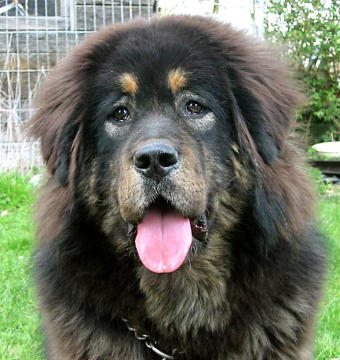 The history of the Tibetan Mastiff – the large guardian dog of Tibet – is hidden in the mists of legend, along with the people of the high Himalayan Mountains and the plains of Central Asia. Accurate records of the genetic heritage of the dogs are non-existent.
The history of the Tibetan Mastiff – the large guardian dog of Tibet – is hidden in the mists of legend, along with the people of the high Himalayan Mountains and the plains of Central Asia. Accurate records of the genetic heritage of the dogs are non-existent.
Even so, history has reserved a special place for the Tibetan Mastiff. They are considered by many to be the basic stock from which most modern large working breeds have developed. Even though a great deal has been written about them since the mid-1880’s there are few specific details available. Some Tibetan Mastiffs evolved as lighter “mountain” dog types and others as “Tsang Kyi”, heavier mastiff types.
Earliest written accounts place a large dog around 1100 BC in China. Skulls of large dogs date from the stone and bronze ages. Ancestors of today’s Mastiff breeds are believed to have accompanied the armies of the Assyrians, Persians, Greeks and Romans and later, traveled with Attilla the Hun and Genghis Khan as far west as Europe. During these centuries, it is believed that the Tibetan Mastiff remained isolated in the mountain valleys of the Himalayas to develop into the magnificent animal so highly prized by the people of Tibet.
Today in Tibet, Nepal, and other Himalayan regions, a pure Tibetan Mastiff is hard to find. However, when available, they are mostly used as livestock guardians well adapted to the rigors of high mountain living. Traveling with the caravans of the Tibetan sheepherders and traders, the dogs are expected to defend the herds and tents of their masters against predators such as wolves and snow leopards. Others are used as homestead guardians, chained to gates and rooftops.
Prior to the early 1800’s, few Westerners were allowed into Tibet so little was known about Tibetan dogs. In accounts of visits to Tibet by early travelers, very little mention was made of the dogs they encountered. In 1800 Captain Samuel Turner, in his “An account of an Embassy to the Court of the Teshoo Lama in Tibet” mentioned his experience with huge dogs. Unfortunately he did not offer a description of the dogs.
In 1847, Lord Hardinge, Viceroy of India, sent a “large dog from Tibet” called “Siring” to Queen Victoria. England had its first dog show in 1859; and in 1873, The Kennel Club was formed with the first Stud Book containing pedigrees of 4027 dogs. In the official classification made by The Kennel Club (England), the “large dog from Tibet” was officially designated the “Tibetan Mastiff” for the first time.
Two more Tibetan Mastiffs were brought into England in 1874 by the then Prince of Wales (later King Edward VII) and they were exhibited at the Alexandra Palace Show, December 1875. From then until 1928, there was a trickle of imports into England and Europe. In 1928, the Hon. Colonel and Mrs. Bailey imported four Tibetan Mastiffs which they obtained while Colonel Bailey was on duty as Political Officer in Sikkim, Nepal, and Tibet. In 1931 Mrs. Bailey formed the Tibetan Breeds Association in England and the first official standard for the breed was adopted by The Kennel Club. It was also the standard used by the Federation Cynological International (FCI) – the umbrella organization for all dog clubs in the world with the exception of The Kennel Club in England and the American Kennel Club.
From World War II until 1976 there were, apparently, no known importation’s of Tibetan Mastiffs from Nepal or India into England. Since 1976, there have been several Tibetan Mastiffs imported into England from various countries and the breed has been recognized by The Kennel Club in the Miscellaneous Class. The breed seems to be well on its way to becoming established in England.
In the late 1950’s two Tibetan Mastiffs were sent from Tibet to President in the USA. They were taken to a farm in the midwest and nothing more was heard of them. Beginning in 1970, several Tibetan Mastiffs were imported from Nepal and India into the USA. These few foundation dogs have been bred throughout the country by concerned and dedicated breeders. The dogs have adapted well to life in the various climates and circumstances of the USA. The Tibetan Mastiff is popular as a companion/protector.
The first National Specialty Match was held in the USA in connection with the California Rare Breeds Dog Association in October 1979. It was a fitting and appropriate debut in the show ring for these fascinating dogs from the Himalayan Mountains of Asia.
The close relationship of the Tibetan Mastiff with man throughout the centuries has given the dog a almost uncanny “human” understanding. Generations of working as a guardian of yak and sheep, requiring always a protector and not a killer, has produced a disposition and temperament of controlled strength, initiative, and fearlessness, tempered with patience, loyalty, and gentleness.


